Experts Share How To Protect Your Outdoor Plants From Extreme Heat
Heat waves are becoming more and more prominent—here's what to know to keep your garden safe, plus which plants to choose for drought-prone environments.
Heat waves have swept across the country this summer, wreaking havoc on just about everything under the sun—causing heatstroke, wildfires, drought, and overall devastating impacts. While it's important to take health and climate risks posed by extreme heat seriously, the smaller-scale impacts shouldn't be overlooked either.
Take your outdoor garden: Though saving your plants might not feel as pressing, if you've spent time and effort curating and caring for a large spread of outdoor plants, that shouldn’t go to waste.
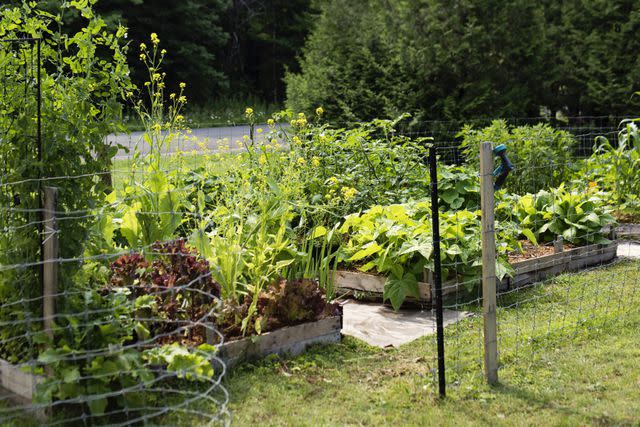
If your garden looks more wilted each time temperatures climb, don’t give up just yet. Here's what master gardeners (from some especially heat-prone states) recommend when it comes to caring for an outdoor garden in extreme conditions, plus insight on which plants will best be able to put up a fight.
Related: Will Wildfire Smoke Harm Your Outdoor Plants?
What happens to plants when they’re exposed to extreme heat?
Just because plants rely on photosynthesis doesn’t mean unlimited sun is good for them. If you’re wondering why heat is so bad for your plants, here’s a quick rundown: While you won’t need to know the ins and outs of plant biology to be able to care for your garden, it’s helpful to know what they’re going through when a heat wave hits.
Plants have small pore-like openings called stomata, which help regulate the amount and distribution of water that’s absorbed. The water, which is used to regulate plants’ metabolic functions and ability to grow, enters the plant through the roots and travels upward with the help of capillary action, sort of like the plant equivalent of a pumping heart. The stomata then opens up—usually at nighttime when temperatures cool—which regulates the plant’s temperature and reduces overall water loss.
When exposed to extreme heat conditions, the plant can’t afford to lose any water, even the amount it needs to to cool itself off, so the whole system falls apart. This is why a heat wave—plus the especially dry environment it causes—can cause some serious problems.
“Unfortunately when the plant’s facing drought, it has to close down those pores so it doesn’t dry itself out by loss of water,” says Michael Chamberland, an urban horticulture expert who works with the Maricopa County Master Gardener program in Arizona. “That both stops the movement of water for the plant, and also it eliminates that cooling aspect—that’s why heat can be a problem, especially dry heat.”
Humid heat can wreak havoc on the system, too. Though water might be released through the stomata, evaporation takes longer in air that’s already almost saturated with water molecules.
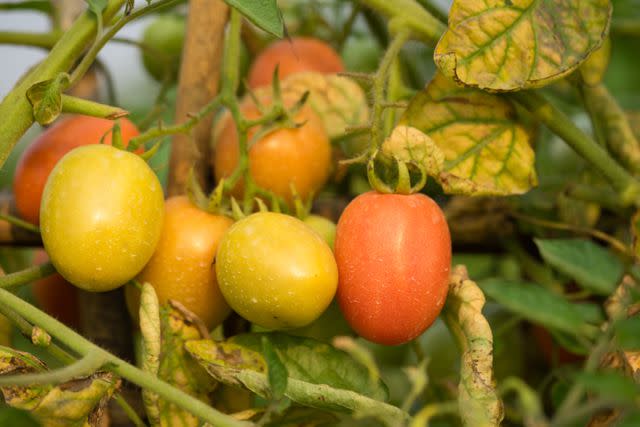
vinhdav / Getty Images
How can you tell that your plants need a little extra care?
It’s clear that hotter-than-average temperatures aren’t great for your garden, but what signs of stress should you look out for when a heat wave hits? The short answer is that it really depends on the plant. Some greenery will show its dehydration, making it easy to tell when to break out the hose, but others might not appear to be damaged until it’s nearly too late.
“It really depends on the different plants—plants show things differently,” says Jayla Fy, program coordinator for the Texas Master Gardener program. “Lawns will wilt, and they’ll dull in appearance. One telltale sign that a lawn is suffering is you can walk across your lawn and you can see the steps where you have been. But some plants are different, and they may not show it until all of a sudden they drop their leaves.”
Related: 6 Beginner Lawn Care Mistakes that Keep Lush Grass from Growing
Some common signs of damage include dulling, wilting, and leaves beginning to roll, but Fry says that it’s important to observe your plants closely—it becomes easier to tell when to intervene as you gain more gardening experience. In the meantime, what’s the solution for this predictability problem? Checking your soil’s moisture.
“My predecessor used to always say we all have moisture meters—stick your finger down in the soil and feel,” Fry says.
You’ll want to make sure that the soil surrounding your garden is damp, all the way past the plants’ roots. If you’re not the biggest fan of dirt under your nails, though, Chamberland has another option to fall back on: a soil probe. This simple tool, a usually 3-foot-long metal rod, can be pushed into the ground to scope out how far down the moisture goes.
“If you stick that probe down into the soil, it’ll slide through the moist soil,” says Chamberland. “It’ll stop once it reaches the dry zone down below, which is a very useful technique because it would otherwise be rather hard to determine whether your water only went down 3 feet or 2 feet. It’s a nifty trick to figure that out.”
If you’ve checked the soil’s moisture—whether you went the finger or probe route—and it’s feeling a little dry, it's time to take some steps to bring your garden back to life.
What You Can Do to Help Your Garden Bounce Back from a Heat Wave
When you’ve noticed some damage, the solution is fairly obvious: You’ll need to water your plants. But it’s not that simple: There are some important precautions to keep in mind to avoid wasting water during a drought-prone time period—and to make sure your plants are getting watered the right way.
According to Chamberland, most people water their plants too often, and they don’t supply enough water each time they do. Trees and other bigger plants need a significant soak so that the water reaches their large root systems.
“They apply a little bit of water every day,” Chamberland says. “That can be good for vegetables and flowers and small plants, but that really creates problems with trees and other larger plants.”
Watering your plants every day (or simply more frequently than they need to be) can be damaging because it doesn’t give the soil enough time to dry before the next soak session. Though you should keep the soil moist, soil that never dries or is sopping wet is prone to increased mold, rot, and microorganism growth. This can deprive the roots of your plants of oxygen, a vital part of their photosynthetic diet. Just be sure to check the soil—especially when the temperature is high—to ensure you’re not over- or under-watering.
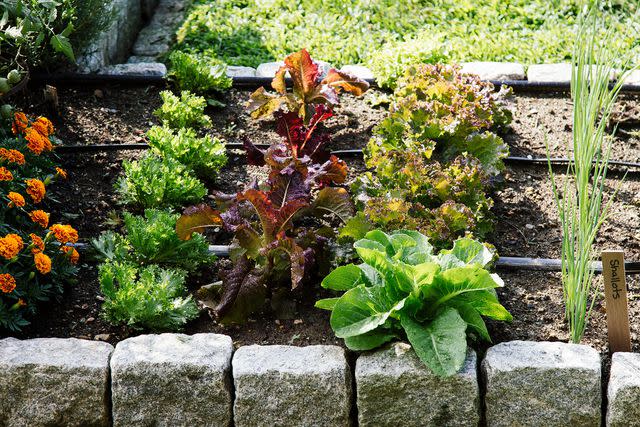
Try out a new irrigation system
Though the concept of irrigation may sound intimidating, implementing an irrigation system doesn’t necessarily mean embarking on an expensive or extensive garden renovation. Fry suggests following a cycle-and-soak pattern—watering in short, 15-minute-long intervals with breaks in between—to reduce runoff and allow your plants to become more resilient. Cycle-and-soak irrigation can be done by hand, or integrated into a landscape’s design with more technical irrigation systems.
“[If you] really allow that moisture to drop deep into the soil, the roots of the plant will search for that moisture,” Fry says. “If you’re just watering the very top layer of your soil, that's where your roots are going to stay, and so it doesn't have as great a capacity to pull from the moisture… You train your plants, essentially, to seek out the moisture.”
Fry also recommends watering your garden via drip irrigation: This can look as simple as a soaker hose placed in vegetable or flower beds or a DIY version using kits you can purchase online. This method not only conserves water, but it also takes care of any over- or under-watering concerns you may have. Plus, the systems can be rigged to run automatically, so you don’t have to run back and forth to turn on the hose.
“Adding drip irrigation to your planting areas really is a water saver,” Fry says. “What that does is that it waters plants in the root zone where it's needed instead of up over the top of the plant, which can lead to evaporation. So that's also a very good way to help conserve water and handle the heat situations and the drought.”
Related: 25 Outdoor Succulent Container Ideas that Resist Heat and Drought
Know the right time to plant
When working to prevent heat damage, avoid planting any new greenery during a heat wave (or during the hottest months of the year, unless you live somewhere fairly mild). Starting the plants off in a stressful environment won’t set them up for success.
“At that time of the year, it’s stressful on a plant to be planted,” Chamberland says. “They're going, usually, from a pot into the soil, so the root environment is changing.”
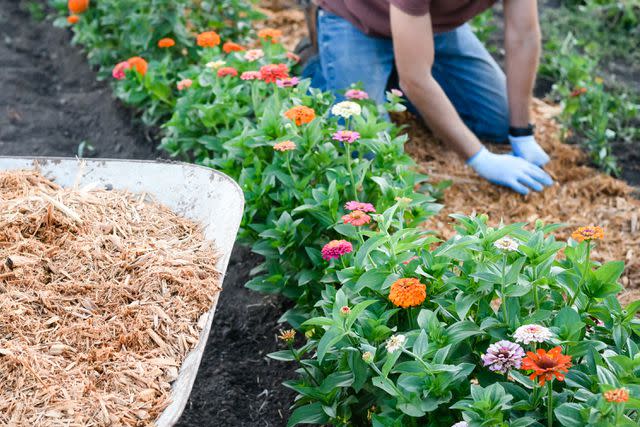
Kelli Jo Emanuel / BHG
Mulching (in moderation) will be your best friend
Beyond coordinating planting times to avoid extreme heat, Fry says mulching is one of the best things you can do to get ahead of the adverse effects of a heat wave. This simple and affordable fix can make your plants much more resilient, and you can customize which mulch to use to best suit your other gardening needs—mulch is a very personal choice, according to Fry.
“I cannot stress mulching enough,” she says. “Mulching does so many things. It’s also nice to look at, but it decreases weeds. Weeds also will take moisture out of the soil and away from the plants that you want… Mulch will help decrease the weeds, it’ll help decrease evaporation from the soil, it’ll help moderate the soil temperature. So I can’t stress mulching enough—even your container plants can benefit from mulching.”
Just make sure you still have enough water to maintain the mulch. If you’re dealing with water restrictions or extreme drought conditions, mulch without water can damage your plants even further.
Related: 9 Ways to Avoid the Worst Mulch Mistakes in Your Garden
When all else fails, test out some plant coverings
If mulching and irrigation aren't doing enough, it might be time to look into plant coverings. Horticultural shade cloth is the technical term, but just about any kind of cover will do—Chamberland says you can even use window screens.
He suggests finding netting that allows around 70% of the sunlight in (usually marketed as offering 30% shading). This is a great trick for especially sensitive plants that need a bit of extra care during the worst of heat waves.
Just keep in mind that too much shade can be a bad thing too—your plants might burn when re-exposed to full sunlight if you cover them all summer. Another quick trick? Simply move your potted plants to shadier areas (even inside will do) when the heat hits. Even if they normally need full sunlight, this will give them the chance to cool down.
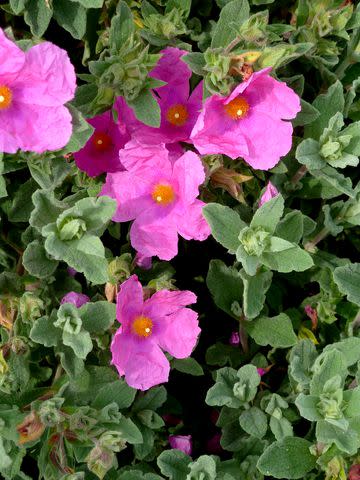
What types of plants thrive in extreme heat?
A great place to start with any garden is knowing which plants will thrive in your area’s climate—that way you won’t create a headache for yourself down the road by planting, say, a willow tree in the desert.
“It’s always tempting to try to push the envelope and grow something neat and unusual, but you have to pay the risk as well,” Chamberland says.
Luckily, many resources exist to help you identify the best choices for your backyard. Fry suggests reaching out to your local master gardeners or botanical gardens to see which varieties they recommend. Also, taking a drive or stroll around your neighborhood to see what’s thriving in your neighbors’ yards can help you make plant picking decisions based on real-life evidence.
Chamberland recommends looking into plants that are native to your area so you’re working with nature, not against it. In Phoenix, he says desert-adapted plants and citrus trees often thrive, but this will vary depending on your state, city, or even neighborhood.
Related: 7 Heat-Tolerant Annuals That Bloom All Summer Long
For more Better Homes & Gardens news, make sure to sign up for our newsletter!
Read the original article on Better Homes & Gardens.

